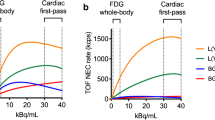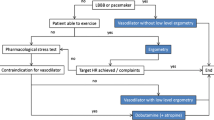Abstract
Objectives
To investigate the diagnostic performance of 70-kVp stress dynamic myocardial CT perfusion (CTP) as a low-dose, one-stop cardiac CT examination in clinical application.
Materials and methods
Consecutive symptomatic patients were prospectively recruited and scanned with stress dynamic myocardial CTP. The CTP phase with the best enhancement of the coronary arteries was selected and extracted as the CTP-derived single-phase coronary CT angiography (SP-CTA). The diagnostic performance of CTP and CTP+SP-CTA for functionally significant CAD was assessed. Invasive coronary angiography and fractional flow reserve were used as the reference standard for the myocardial ischemia evaluation.
Results
In total, 71 patients (43 men and 28 women; 63.6 ± 8.8 years old) underwent the stress dynamic myocardial CTP; 63 vessels (36.2%) from 42 of the patients (59.2%) were identified as causing ischemia. On a per-vessel basis, the sensitivity, specificity, PPV, NPV, and diagnostic accuracy for CTP and CTP+SP-CTA were 77.8%, 93.7%, 87.5%, 88.1%, and 87.9% and 84.1%, 93.7%, 88.3%, 91.2%, and 90.2%, respectively. The area under the curve (AUC) of CTP+SP-CTA (AUC = 0.963; 95%CI, 0.938–0.989) was significantly superior to that of CTP (AUC = 0.922; 95%CI, 0.880–0.964) and that of SP-CTA (AUC = 0.833; 95%CI, 0.765–0.900) alone (all p < 0.01). The mean radiation dose of the CTP examination was 3.8 ± 1.4 mSv.
Conclusion
CTP-derived SP-CTA improved the diagnostic value of CTP. With a promising performance of myocardial ischemia detection and low radiation dose, the innovative low-dose, one-stop CTP examination is clinically feasible for patients who need to receive a myocardial perfusion assessment.
Key Points
• Myocardial CTP performed well in the evaluation of hemodynamically significant CAD.
• CTP-derived single-phase CCTA improved the diagnostic value of CTP.
• The combined use of low-dose CTP and CTP-derived CCTA at 70 kVp is clinically feasible for CAD patients who need to receive a myocardial perfusion assessment.





Similar content being viewed by others
Abbreviations
- ATP:
-
Adenosine triphosphate
- CAD:
-
Coronary artery disease
- CCTA:
-
Coronary CT angiography
- CM:
-
Contrast media
- CT:
-
Computed tomography
- CTP:
-
CT perfusion
- DSCT:
-
Dual-source CT
- ED:
-
Effective radiation dose
- FFR:
-
Fractional flow reserve
- ICA:
-
Invasive coronary angiography
- IQ:
-
Image quality
- MBF:
-
Myocardial blood flow
- SP-CTA:
-
Single-phase coronary CT angiography
References
SCOT-HEART investigators (2015) CT coronary angiography in patients with suspected angina due to coronary heart disease (SCOT-HEART): an open-label, parallel-group, multicentre trial. Lancet 385(9985):2383–2391
George RT, Mehra VC, Chen MY et al (2015) Myocardial CT perfusion imaging and SPECT for the diagnosis of coronary artery disease: a head-to-head comparison from the CORE320 multicenter diagnostic performance study. Radiology 274(2):626
Wang Y, Qin L, Shi X et al (2012) Adenosine-stress dynamic myocardial perfusion imaging with second-generation dual-source CT: comparison with conventional catheter coronary angiography and SPECT nuclear myocardial perfusion imaging. AJR Am J Roentgenol 198(3):521–529
Lu M, Wang S, Sirajuddin A, Arai AE, Zhao S (2018) Dynamic stress computed tomography myocardial perfusion for detecting myocardial ischemia: a systematic review and meta-analysis. Int J Cardiol 258:325–331
van Rosendael AR, Dimitriu-Leen AC, de Graaf MA et al (2017) Impact of computed tomography myocardial perfusion following computed tomography coronary angiography on downstream referral for invasive coronary angiography, revascularization and, outcome at 12 months. Eur Heart J Cardiovasc Imaging 18(9):969–977
Lubbers M, Coenen A, Kofflard M et al (2018) Comprehensive cardiac CT with myocardial perfusion imaging versus functional testing in suspected coronary artery disease: the multicenter, randomized CRESCENT-II trial. JACC Cardiovasc Imaging 11(11):1625–1636
Rochitte CE, George RT, Chen MY et al (2014) Computed tomography angiography and perfusion to assess coronary artery stenosis causing perfusion defects by single photon emission computed tomography: the CORE320 study. Eur Heart J 35(17):1120–1130
Magalhaes TA, Kishi S, George RT et al (2015) Combined coronary angiography and myocardial perfusion by computed tomography in the identification of flow-limiting stenosis - the CORE320 study: an integrated analysis of CT coronary angiography and myocardial perfusion. J Cardiovasc Comput Tomogr 9(5):438–445
Rybicki FJ, Mather RT, Kumamaru KK et al (2015) Comprehensive assessment of radiation dose estimates for the CORE320 study. AJR Am J Roentgenol 204(1):W27–W36
Wong DT, Ko BS, Cameron JD et al (2014) Comparison of diagnostic accuracy of combined assessment using adenosine stress computed tomography perfusion + computed tomography angiography with transluminal attenuation gradient + computed tomography angiography against invasive fractional flow reserve. J Am Coll Cardiol 63(18):1904–1912
Fujita M, Kitagawa K, Ito T et al (2014) Dose reduction in dynamic CT stress myocardial perfusion imaging: comparison of 80-kV/370-mAs and 100-kV/300-mAs protocols. Eur Radiol 24(3):748–755
Mangold S, De Cecco CN, Wichmann JL et al (2016) Effect of automated tube voltage selection, integrated circuit detector and advanced iterative reconstruction on radiation dose and image quality of 3rd generation dual-source aortic CT angiography: an intra-individual comparison. Eur J Radiol 85(5):972–978
Yi Y, Wu W, Lin L et al (2018) Single-phase coronary artery CT angiography extracted from stress dynamic myocardial CT perfusion on third-generation dual-source CT: validation by coronary angiography. Int J Cardiol 269:343–349
van Assen M, Pelgrim GJ, De Cecco CN et al (2019) Intermodel disagreement of myocardial blood flow estimation from dynamic CT perfusion imaging. Eur J Radiol 110:175–180
Wichmann JL, Meinel FG, Schoepf UJ et al (2016) Semiautomated global quantification of left ventricular myocardial perfusion at stress dynamic CT:: diagnostic accuracy for detection of territorial myocardial perfusion deficits compared to visual assessment. Acad Radiol 23(4):429–437
Rossi A, Wragg A, Klotz E et al (2017) Dynamic computed tomography myocardial perfusion imaging: comparison of clinical analysis methods for the detection of vessel-specific ischemia. Circ Cardiovasc Imaging 10(4):e005505
Donato P, Coelho P, Santos C, Bernardes A, Caseiro-Alves F (2012) Correspondence between left ventricular 17 myocardial segments and coronary anatomy obtained by multi-detector computed tomography: an ex vivo contribution. Surg Radiol Anat 34(9):805–810
Kuhl JT, George RT, Mehra VC et al (2016) Endocardial-epicardial distribution of myocardial perfusion reserve assessed by multidetector computed tomography in symptomatic patients without significant coronary artery disease: insights from the CORE320 multicentre study. Eur Heart J Cardiovasc Imaging 17(7):779–787
Rocha-Filho JA, Blankstein R, Shturman LD et al (2010) Incremental value of adenosine-induced stress myocardial perfusion imaging with dual-source CT at cardiac CT angiography. Radiology 254(2):410–419
Ko BS, Cameron JD, Leung M et al (2012) Combined CT coronary angiography and stress myocardial perfusion imaging for hemodynamically significant stenoses in patients with suspected coronary artery disease: a comparison with fractional flow reserve. JACC Cardiovasc Imaging 5(11):1097–1111
Siontis KC, Gersh BJ, Williamson EE, Foley TA, Askew JW, Anavekar NS (2016) Diagnostic performance of myocardial CT perfusion imaging with or without coronary CT angiography. JACC Cardiovasc Imaging 9(3):322–324
Meyer M, Haubenreisser H, Schoepf UJ et al (2014) Closing in on the K edge: coronary CT angiography at 100, 80, and 70 kV-initial comparison of a second- versus a third-generation dual-source CT system. Radiology 273(2):373–382
Acknowledgments
We thank Dr. Wei Han for kindly providing statistical advice for this manuscript and thank ASCI Cube ([ASCI]3) 2019 Program for the article discussion during the Program.
Funding
This study has received funding from the National Key Research and Development Program of China (Grant Nos. 2016YFC1300402, 2016YFC1300400, 2016), the Beijing Municipal Natural Science Interdisciplinary cooperation project Foundation (Grant No. Z171100001117136, 2017), and the National Natural Science Foundation of China (Grant No. 81873891, 2019).
Author information
Authors and Affiliations
Corresponding authors
Ethics declarations
Guarantor
The scientific guarantor of this publication is Zheng-Yu Jin.
Conflict of interest
The authors of this manuscript declare no relationships with any companies, whose products or services may be related to the subject matter of the article.
Statistics and biometry
Dr. Wei Han kindly provided statistical advice for this manuscript.
Informed consent
Written informed consent was obtained from all subjects (patients) in this study.
Ethical approval
Institutional Review Board approval was obtained.
Methodology
• prospective
• diagnostic or prognostic study
• performed at one institution
Additional information
Publisher’s note
Springer Nature remains neutral with regard to jurisdictional claims in published maps and institutional affiliations.
Yi-Ning Wang is the first corresponding author and Zheng-Yu Jin is the second corresponding author of this work.
Rights and permissions
About this article
Cite this article
Yi, Y., Xu, C., Wu, W. et al. Low-dose CT perfusion with combined use of CTP and CTP-derived coronary CT angiography at 70 kVp: validation with invasive fractional flow reserve. Eur Radiol 31, 1119–1129 (2021). https://doi.org/10.1007/s00330-020-07096-x
Received:
Revised:
Accepted:
Published:
Issue Date:
DOI: https://doi.org/10.1007/s00330-020-07096-x




